BOOM! Studios Sees The Future Is A Turncoat
Jan 19, 2016
by Vince Brusio
Employing the most compelling elements of science fiction and the detective genre, Turncoat is a gripping exploration of power vacuums and the legacy of oppression. Alex Paknadel (Arcadia) and Artyom Trakhanov (Undertow) tell the story of a guilt-ridden protagonist through a grisly quest for a truth. Turncoat #1 (JAN161190) will scratch that itch you have for dark sci-fi like Blade Runner, The Forever War, and Neuromancer. Read below for our PREVIEWSworld Exclusive interview with the series' creators!
**********
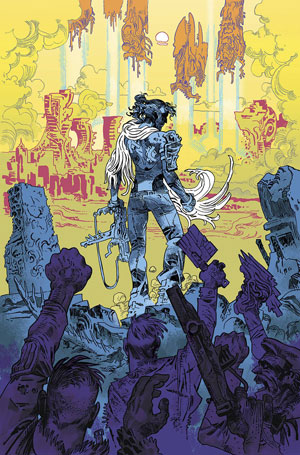 PREVIEWSworld: Turncoat #1 (JAN161190) is being pitched as a story about exploring power vacuums and the legacy of oppression. Could you expand on that premise a bit for us?
PREVIEWSworld: Turncoat #1 (JAN161190) is being pitched as a story about exploring power vacuums and the legacy of oppression. Could you expand on that premise a bit for us?
Alex Paknadel: Sure thing. I guess if I look at all the projects I have in train at the moment, what unites them thematically is a quite intentional fixation on aftermaths. We usually leave stories at the moment of triumph because that’s the most narratively satisfying jumping-off point, but I’ve always been interested in the silence afterwards; in that moment of political freefall between, say, the Death Star Mk II exploding and the founding of the New Republic. Who’s been waiting patiently in the shadows for this moment to attempt a power grab? What behaviors have we unwittingly inherited from our oppressors? Can we remember who we were before they seized power?
Turncoat is set in the aftermath of a 300-year occupation by a brutal alien race whose communication with humanity was so intermittent and remote that we simply called them “Management.” One day they left without warning, leaving their infrastructure and control mechanisms intact. This is cause for celebration for those who suffered under them of course, but there’s a question on everyone’s lips which betrays a kind of mass Stockholm Syndrome: “Why did they abandon us?” That bizarre and irrational sense of rejection, that fear of total freedom, is what excites me about Turncoat.
PREVIEWSworld: Are there any current (or past?) events that helped serve as food for thought when the idea for Turncoat was being formulated?
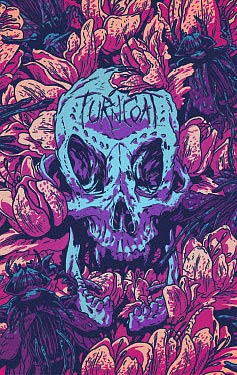 Alex Paknadel: I have to be very careful with this question because I don’t want to pin Turncoat to any one historical conflict, but the idea coalesced around this idea that empires and dictatorships are a bit like ticks: Sometimes when they’re ousted they can leave mouthpieces and infectious tissue to rot in the wound. The formerly subjugated people may think they’re free, but the ideology of the hegemon is deep inside them like Lyme disease, polluting their politics for generations afterwards.
Alex Paknadel: I have to be very careful with this question because I don’t want to pin Turncoat to any one historical conflict, but the idea coalesced around this idea that empires and dictatorships are a bit like ticks: Sometimes when they’re ousted they can leave mouthpieces and infectious tissue to rot in the wound. The formerly subjugated people may think they’re free, but the ideology of the hegemon is deep inside them like Lyme disease, polluting their politics for generations afterwards.
It’s not that simple, of course. Sometimes a colonizing power will actually improve infrastructure, legal systems, education, etc., but for the purposes of Turncoat I’m viewing occupation/dictatorship as trauma and the aftermath as an expression of a kind of mass PTSD.
PREVIEWSworld:What can you tell us about the main characters in this book? What makes them tick? What pushes their buttons?
Alex Paknadel: The most important (and most elusive) character(s) in the book are Management themselves. The decision was taken very early on in the process to never reveal what they actually look like. Artyom knows what they look like and so do I, but you won’t be seeing them in the comic. Instead we want them to be this menacing absent presence, still tormenting humanity despite being long gone.
Our protagonist is Marta Gonzalez, a former officer with the NYPD under Management rule and now a private investigator. For reasons that will become clear, Marta betrayed Management just before they left, which appalled Management loyalists and made the rebels deeply suspicious. She’s the titular Turncoat, but she really doesn’t have anywhere to call home. Like all the best fictional PIs she’s impetuous, good with her fists, and permanently drunk.
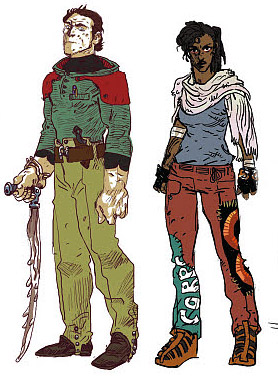 Matt Dyson is Marta’s old partner in the NYPD. He managed to keep his job under the post-withdrawal settlement, but it means he has to share a badge with the rebels he used to hunt in a merged NYPD composed of resistance fighters and loyalists. He just wants to work long enough to get his pension and move to the suburbs, but he also feels obligated to keep Marta safe. She was reckless before and she’s reckless now, but these days she doesn’t have any backup apart from him.
Matt Dyson is Marta’s old partner in the NYPD. He managed to keep his job under the post-withdrawal settlement, but it means he has to share a badge with the rebels he used to hunt in a merged NYPD composed of resistance fighters and loyalists. He just wants to work long enough to get his pension and move to the suburbs, but he also feels obligated to keep Marta safe. She was reckless before and she’s reckless now, but these days she doesn’t have any backup apart from him.
William Mann was the leader of the “Anthropartisan” resistance movement/terrorist organization under Management rule. Now that the invaders have left, he’s maneuvered himself and his old comrades in the resistance into positions of power throughout the country. He saved Marta’s life when she was a Management cop for reasons not even he can explain, but ever since then they’ve had an understanding. When Marta betrayed her own people, it was to Mann. Now that the peace is relatively well established, Marta and Mann see each other fairly infrequently, but it’s always memorable. He has the most to lose from the events in the book, so watching him walk the thin line between politician and brawler is fascinating to me.
PREVIEWSworld: The artwork for this book is very kinetic. Very emotional. Were the layouts developed closely to the script, or did you have a lot of rope to play with when you sat down at the drawing board?
Artyom Trakhanov: Aw, thank you! I think I could’ve wandered pretty far from some parts of the script if I wanted, but I must confess that Alex’s ways of describing emotions, actions, and scenery are usually so on point that I don’t even think about it. Of course, there are some small tweaks here and there, but in Turncoat, most of my autocracy comes in the form of my character designs and visual choices, rather than in any sequential scenes. I did some pretty weird design choices on my own, and I’m glad that Alex and the rest of our team were on board with my weird additions so far!
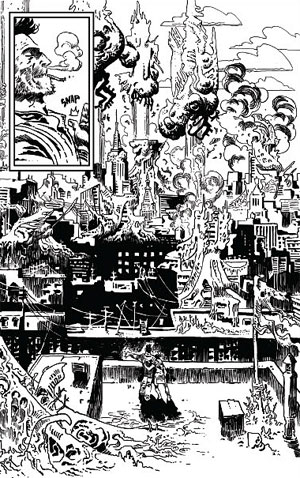 PREVIEWSworld: Turncoat is visually striking, and seems to be as much a storyboard for a screenplay as it does a comic book. What references did you draw from when the scenes were first conceived?
PREVIEWSworld: Turncoat is visually striking, and seems to be as much a storyboard for a screenplay as it does a comic book. What references did you draw from when the scenes were first conceived?
Artyom Trakhanov: I tend to believe that a good comic is 100% a comic book first, not a storyboard, and that’s very important for me. There are so many nuances in managing an entire page’s layout that, to me, working on a comic always means thinking in pages, not just in panel formations. Because of that, my brain will never lack any possible reference material—from video games to movies or books and even small bits of Russian culture. For example, right now I’m reading a book by the Strugatsky brothers with incredible illustrations by Russian illustrator Yevgeniy Migunov, so you should definitely expect some influences in issue #3!
Alex Paknadel: The visual identity of the book is mostly Artyom’s doing. He has a tremendous capacity for taking vague ideas and running with them. All I knew going in was that I wanted New York to resemble a termite mound, and for every cultural artifact to have a kind of insectoid influence. Used futures are pretty commonplace, but the idea here was that this was a future that had been used by someone else. Apart from those rather skeletal notes, everything you see is pure Artyom, which is exactly what I wanted and exactly why our editors, Jasmine Amiri and Eric Harburn, thought we’d work well together. Artyom’s really made this world his own.
PREVIEWSworld: What is your parting thought on the work you put into this new series? What part of yourself did you leave behind in Turncoat?
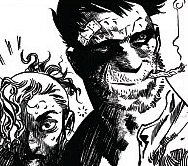 Alex Paknadel: This is my sophomore book—my “tricky second album.” Arcadia was critically well-received and I’m extremely grateful for that, but I felt the hot breath of expectation on my neck early on with this one. BOOM! also decided to pair me with Artyom quite early on in the process, which really forced me to raise my game. However, once the gears started turning and I could see that he was enjoying the work, my nerves almost entirely disappeared. I’m cripplingly British so I constantly worry that I’m going to put people out, but Artyom emailed me one day to tell me how much he was digging the book, which was all I needed to just lean into it and enjoy myself.
Alex Paknadel: This is my sophomore book—my “tricky second album.” Arcadia was critically well-received and I’m extremely grateful for that, but I felt the hot breath of expectation on my neck early on with this one. BOOM! also decided to pair me with Artyom quite early on in the process, which really forced me to raise my game. However, once the gears started turning and I could see that he was enjoying the work, my nerves almost entirely disappeared. I’m cripplingly British so I constantly worry that I’m going to put people out, but Artyom emailed me one day to tell me how much he was digging the book, which was all I needed to just lean into it and enjoy myself.
In short, while I know there are no prizes for effort in comics, I can honestly say that Turncoat is the best work I’ve produced to date. I can say that because I have collaborators who absolutely bring out the best in me.
Artyom Trakhanov: The feeling is mutual, Alex! As for me, I’m mostly leaving behind my blood and sweat on my original pages. The people who buy my original art could probably create clones of me using the DNA!




